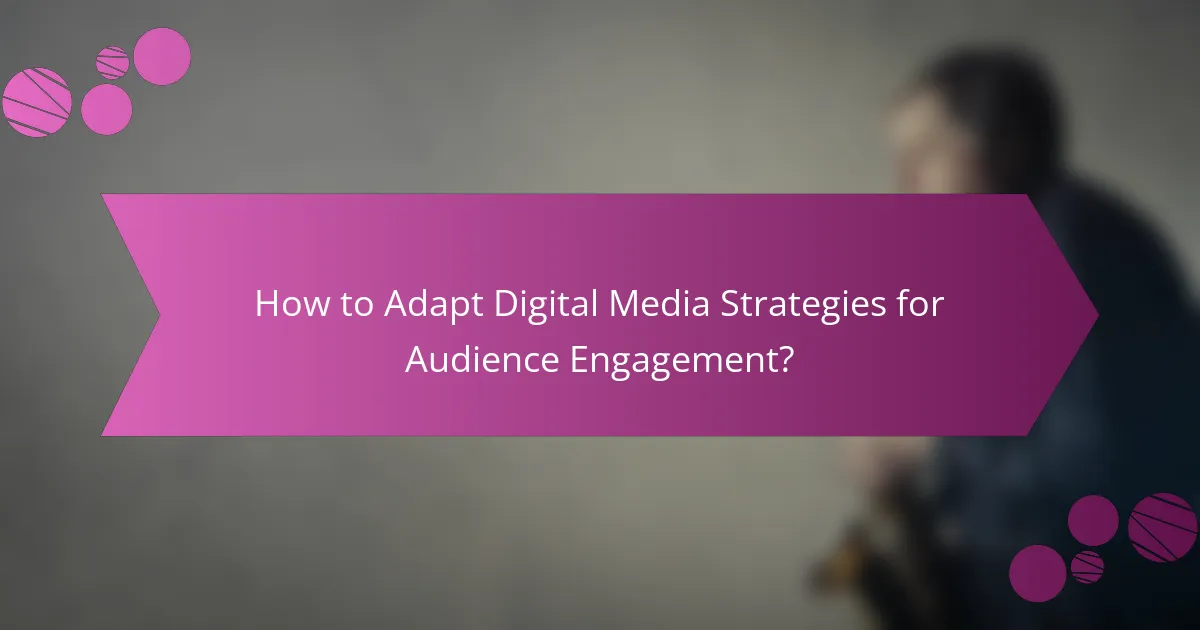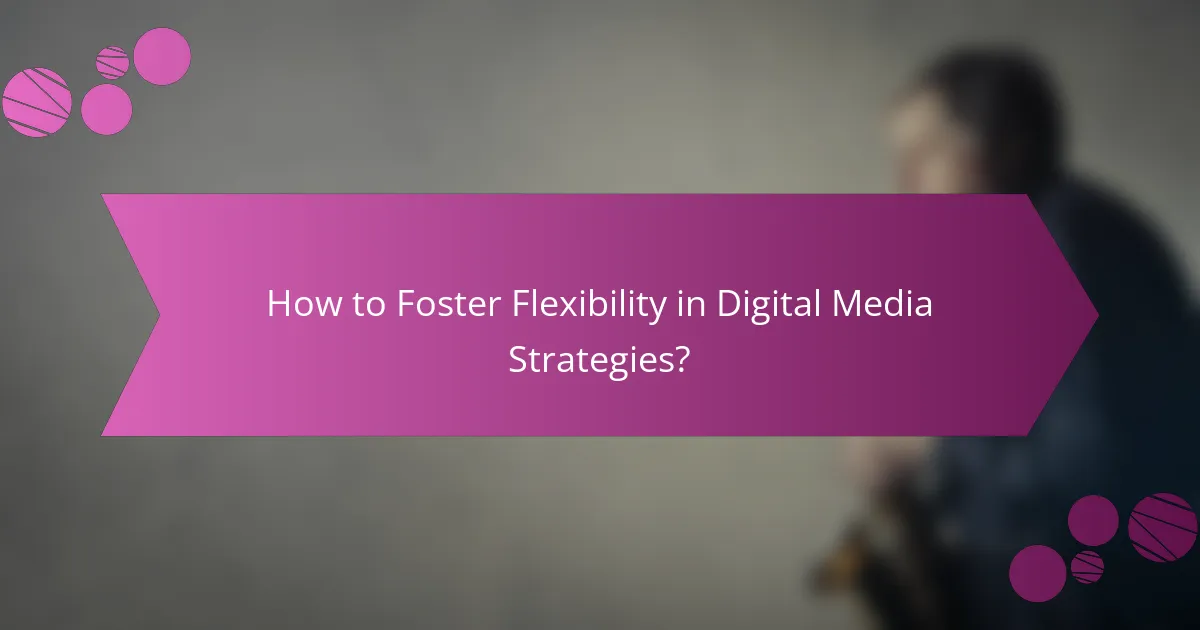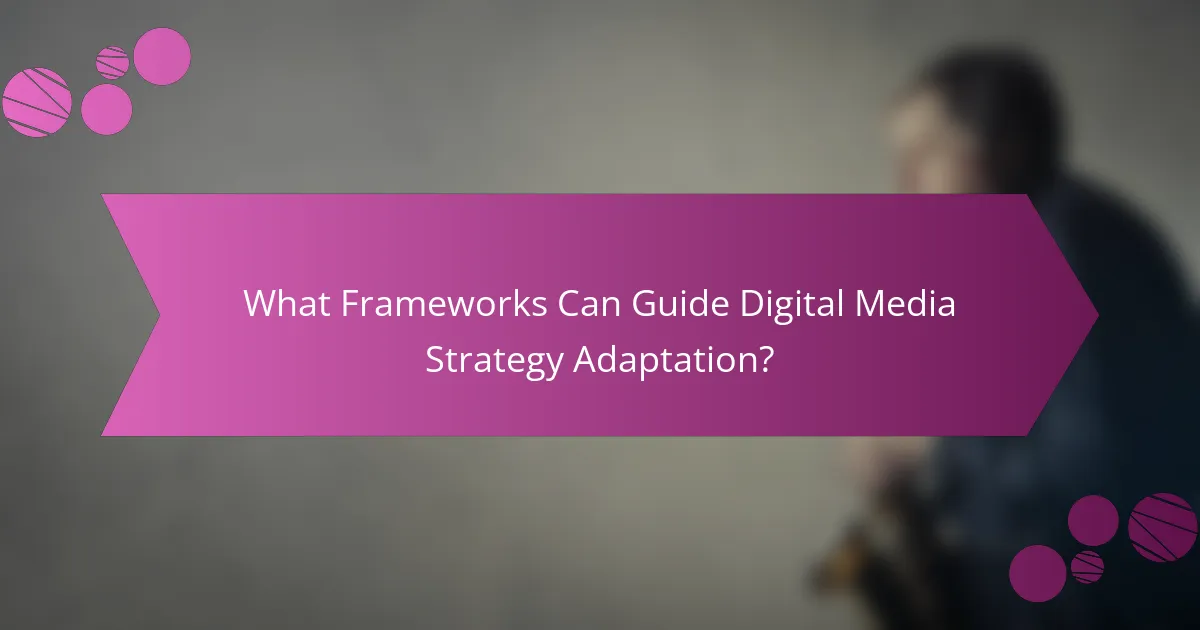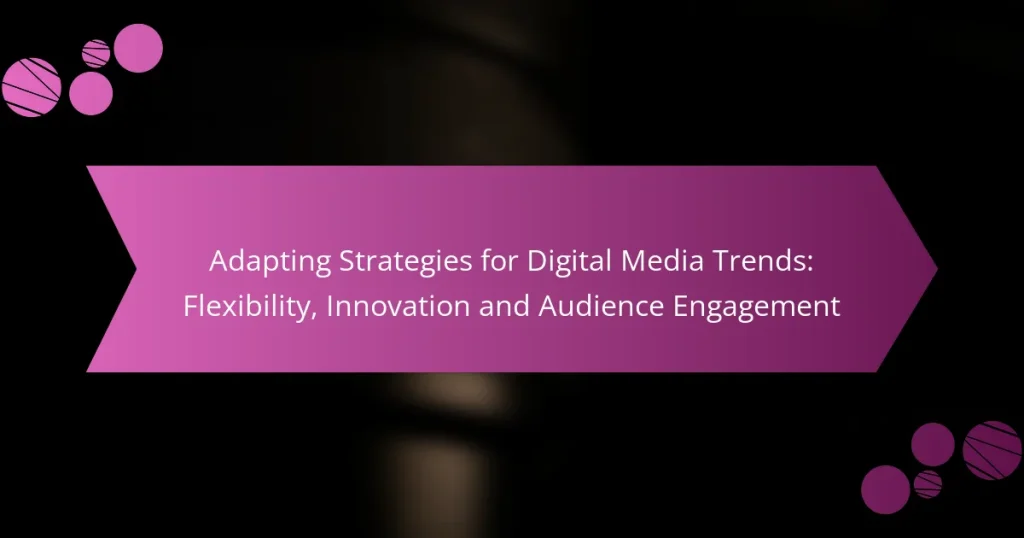In the rapidly evolving landscape of digital media, adapting strategies to enhance audience engagement is crucial. By understanding audience preferences and leveraging innovative technologies like AI and augmented reality, organizations can create immersive experiences that resonate with users. Embracing flexibility and being responsive to feedback ensures that these strategies remain relevant and effective in capturing audience interest.

How to Adapt Digital Media Strategies for Audience Engagement?
To effectively adapt digital media strategies for audience engagement, focus on understanding your audience’s preferences and behaviors. This involves leveraging data analytics, implementing interactive features, and utilizing social media for real-time feedback.
Utilize data analytics for personalized content
Data analytics allows you to gather insights about your audience’s interests and behaviors, enabling you to create personalized content that resonates with them. By analyzing user data, you can identify trends and preferences, tailoring your messaging and offerings accordingly.
Consider using tools like Google Analytics or social media insights to track user engagement metrics. Aim to segment your audience based on demographics, interests, and behaviors, allowing for targeted campaigns that increase relevance and connection.
Implement interactive features for user participation
Interactive features enhance audience engagement by encouraging participation and feedback. Incorporate elements such as polls, quizzes, and comment sections to create a two-way communication channel with your audience.
For example, hosting live Q&A sessions or interactive webinars can foster a sense of community and involvement. Ensure these features are user-friendly and accessible across devices to maximize participation.
Leverage social media platforms for real-time feedback
Social media platforms are invaluable for obtaining real-time feedback from your audience. Utilize these channels to ask questions, conduct surveys, and monitor comments to gauge audience sentiment and preferences.
Engage with your audience by responding promptly to their feedback and adapting your strategies based on their input. This responsiveness not only builds trust but also helps you stay aligned with audience expectations and trends.

What Innovations Are Driving Digital Media Trends?
Innovations such as artificial intelligence, augmented reality, and blockchain technology are significantly shaping digital media trends. These advancements enhance content creation, provide immersive experiences, and ensure secure distribution, making them essential for engaging audiences effectively.
Artificial Intelligence in content creation
Artificial intelligence (AI) is revolutionizing content creation by automating processes and personalizing user experiences. Tools powered by AI can generate articles, videos, and graphics, allowing creators to focus on strategy and creativity rather than repetitive tasks.
For instance, AI-driven platforms can analyze audience preferences and suggest topics that resonate well, increasing engagement rates. However, it’s crucial to maintain a human touch in content to avoid sounding robotic or impersonal.
Augmented Reality for immersive experiences
Augmented reality (AR) enhances digital media by overlaying digital information onto the real world, creating engaging and interactive experiences. Brands are using AR to allow users to visualize products in their own environment, which can significantly boost conversion rates.
For example, furniture retailers often use AR apps to let customers see how a piece of furniture would look in their home. When implementing AR, ensure that the technology is user-friendly and accessible across various devices to maximize reach.
Blockchain for secure content distribution
Blockchain technology is transforming content distribution by providing a secure and transparent method for sharing digital assets. It enables creators to control their work and receive fair compensation through smart contracts, reducing piracy and unauthorized use.
For example, musicians can use blockchain to sell their music directly to fans, bypassing traditional distribution channels. When considering blockchain, be aware of the technical complexities and ensure that your audience is familiar with the technology to facilitate adoption.

How to Foster Flexibility in Digital Media Strategies?
Fostering flexibility in digital media strategies involves embracing change and being ready to pivot based on audience feedback and market trends. This adaptability allows organizations to stay relevant and effectively engage their target audience.
Agile project management methodologies
Agile project management methodologies emphasize iterative progress and collaboration, making them ideal for digital media strategies. By breaking projects into smaller, manageable tasks, teams can quickly respond to changes and incorporate feedback, ensuring that content remains relevant and engaging.
Key practices include regular stand-up meetings, sprint planning, and retrospective sessions. These practices help teams assess their progress and adjust their strategies based on real-time data and audience engagement metrics.
Continuous learning and adaptation practices
Continuous learning and adaptation practices are crucial for maintaining flexibility in digital media. This involves regularly analyzing performance metrics, audience behavior, and industry trends to inform strategic adjustments. Utilizing tools like A/B testing can provide insights into what resonates with your audience.
Encouraging a culture of experimentation within your team can lead to innovative content and formats. Consider setting aside a portion of your budget for testing new ideas, which can yield valuable insights and enhance audience engagement over time.

What Are the Key Metrics for Measuring Engagement?
Key metrics for measuring engagement include click-through rates, social media engagement metrics, and audience retention rates. These metrics provide insights into how effectively content resonates with audiences and can guide strategies for improvement.
Click-through rates for content effectiveness
Click-through rates (CTR) indicate the percentage of users who click on a specific link compared to the total number of users who view the content. A higher CTR suggests that the content is compelling and encourages user interaction. Aim for a CTR of around 2-5% for standard digital campaigns, but this can vary by industry.
To improve CTR, use clear and enticing calls-to-action (CTAs) and ensure that headlines are engaging. Regularly testing different formats and placements can help identify what works best for your audience.
Social media engagement metrics
Social media engagement metrics include likes, shares, comments, and overall interaction rates on platforms like Facebook, Instagram, and Twitter. These metrics reflect how well content is resonating with users and can indicate brand loyalty and community building. A good engagement rate typically ranges from 1-5%, depending on the platform and industry.
To boost social media engagement, create shareable content that encourages interaction, such as polls or questions. Monitoring trends and adapting content to fit current events can also enhance engagement levels.
Audience retention rates
Audience retention rates measure the percentage of viewers who continue to engage with content over time. High retention indicates that your content is valuable and keeps users interested. Aim for retention rates above 50% for video content, while articles should strive for readers to stay on the page for several minutes.
To improve retention, focus on delivering high-quality, relevant content that meets audience needs. Break content into digestible segments and use visuals to maintain interest. Regularly analyze retention data to identify drop-off points and adjust your strategy accordingly.

What Frameworks Can Guide Digital Media Strategy Adaptation?
Frameworks like SWOT and PESTLE provide structured approaches to adapt digital media strategies effectively. These tools help organizations assess internal strengths and weaknesses, as well as external opportunities and threats, ensuring a comprehensive understanding of the landscape.
SWOT analysis for strategic planning
SWOT analysis focuses on identifying an organization’s internal strengths and weaknesses alongside external opportunities and threats. This framework allows businesses to leverage their strengths, address weaknesses, capitalize on opportunities, and mitigate potential threats in the digital media space.
For example, a digital media company might identify its strong brand presence as a strength, while recognizing a lack of mobile optimization as a weakness. Opportunities could include emerging social media platforms, while threats might involve increasing competition or changing consumer preferences.
PESTLE analysis for external factors
PESTLE analysis examines external factors that can impact a digital media strategy, including Political, Economic, Social, Technological, Legal, and Environmental aspects. Understanding these factors helps organizations anticipate changes and adapt their strategies accordingly.
For instance, a change in data privacy regulations could significantly affect how a company collects and uses audience data. Similarly, shifts in economic conditions may influence advertising budgets, requiring a reevaluation of marketing strategies to maintain audience engagement.

How to Choose the Right Digital Media Tools?
Selecting the right digital media tools involves understanding your specific needs, audience preferences, and the features offered by various platforms. Consider factors such as ease of use, integration capabilities, and cost-effectiveness to ensure you make an informed choice.
Identify Your Goals
Begin by clearly defining your objectives. Are you aiming to increase brand awareness, drive sales, or enhance customer engagement? Knowing your goals will help narrow down the tools that best align with your strategy.
For instance, if your focus is on engagement, tools that offer interactive content features, such as polls or quizzes, may be more beneficial than those focused solely on analytics.
Evaluate Your Audience
Understanding your audience is crucial when selecting digital media tools. Analyze their demographics, preferences, and online behavior to choose platforms that resonate with them. Tools that cater to your audience’s habits will yield better results.
For example, if your target audience is primarily active on social media, consider tools that enhance your social media presence, such as scheduling apps or analytics platforms that track engagement metrics.
Consider Budget and Resources
Your budget will significantly influence your choice of digital media tools. Assess the costs associated with each tool, including subscription fees, training, and potential upgrades. Look for tools that offer a good balance between features and affordability.
Additionally, consider the resources you have available, such as team expertise and time. Opt for tools that your team can easily adopt without extensive training, which can save both time and money.
Test and Iterate
Once you’ve selected a few tools, conduct trials to evaluate their effectiveness. Many platforms offer free trials or demo versions, allowing you to test features before committing. Monitor performance metrics closely during this phase.
Be prepared to iterate based on your findings. If a tool isn’t meeting your needs, don’t hesitate to explore alternatives. Flexibility in your approach will help you adapt to changing trends and audience preferences.


